23.12.2023
Descendant could provide clues about short-lived stellar giants hundreds of times bigger than the Sun

The universe’s first stars may have died in “pair-instability” supernovae. Simulations show how the explosions would have seeded subsequent generations of stars with a particular inventory of metals.ASIAA/KEN CHEN
The universe’s very first stars were giants that burned fast and died young in spectacular explosions. They may never be spotted directly—although NASA’s James Webb Space Telescope, which by looking far away can see back to the times when they were shining, may get lucky. In the meantime, astronomers may have discovered the next best thing: a descendant, born from the wreckage of a first-generation star, that has been quietly shining near the Milky Way ever since. A closer inspection, and finding more descendants like it, could clue researchers into how big the first stars were and how they affected the universe’s evolution.
“We’re trying to do forensic analysis of objects that blew up 13.5 billion years ago. They’re just not there anymore,” says astronomer Timothy Beers of the University of Notre Dame, who was not involved in the study. “If this is a pure [descendant], that puts very strong constraints” on the masses of the first stars.
Theorists believe that first-generation stars, known as population III, were made of only the ingredients left over from the big bang, mostly hydrogen and helium. As they burned, they fused those ingredients into heavier elements that astronomers lump together as “metals.” When the stars exploded as supernovae after lifetimes as short as a few million years, the metals spread out and mixed with more hydrogen and helium in later generations of stars.
The limited ingredients in population III stars are thought to be the reason why they grew so big. For a gas cloud to contract into a star, the gas needs to cool. Metals are efficient at converting heat into infrared light that can escape the cloud. Without them, population III stars simply grew and grew until finally gravity overcame the hot gas to ignite a fusion burn in the core.
Opinions differ about just how massive they were, with model predictions varying from a few dozen times the mass of the Sun to 1000 times its mass. Pinning down the size is important because around that time something hot and bright ionized almost all the neutral gas that pervaded the universe. Gigantic population III stars would be a likely culprit, smaller ones less so.
Although observers may never directly measure the size of a population III star, they could detect traces left behind when the stars die in a rare form of explosion called a “pair-instability” supernova, which occurs if the stars had a mass between 140 and 260 times that of the Sun. In such a star, the superheated core fires out gamma rays, which exert an outward pressure and prop up the star’s outer layers. If the gamma ray energy gets too high, however, the rays can instead transform into pairs of electrons and positrons and stop exerting pressure. Without that pressure, the outer layers come crashing down, sparking a runaway fusion reaction that blows the star apart. Models suggest pair-instability supernovae produce a particular pattern of metal abundances that could then be taken up by the next generation of stars.
That pattern would show up in a descendant star’s elemental composition like a fingerprint, which astronomers can read in a spectrum of the star’s light. For a couple of decades, they have been looking for these signatures in large surveys which routinely record the spectra of millions of objects across the sky. But the search for signs of a pair-instability supernova has been frustrating. In one such effort, a team led by the University of Florence announced earlier this year that it had found 166 candidate population III descendants after analyzing spectra from 1.4 million Milky Way stars. But none made the cut when a more detailed spectrum was taken. “I was starting to doubt if these stars even existed,” says University of Florence astronomer Ioanna Koutsouridou.
In June, however, researchers on another team revealed they had hit the jackpot, using China’s Large Sky Area Multi-Object Fibre Spectroscopic Telescope (LAMOST). They found a star, known as J1010+2358, in the sparse halo of stars that surrounds the Milky Way that was strikingly low in metals. And for the individual metals the team could detect, the star also displayed sharply differing abundances for elements with odd and even atomic numbers—a telltale sign of a pair-instability supernova. “It was a perfect fit,” Koutsouridou says.
Last week, she and her colleagues took the LAMOST team’s analysis a step further in a preprint posted on arXiv. They compared the metal abundances in J1010+2358 with various models of population III stars and their supernovae. They conclude it was likely the descendant of a star weighing 250 to 260 solar masses, evidence in favor of middle-weight population III stars. But it’s not yet clear whether the predecessor was typical or an outlier. Koutsouridou and her team hope to firm this up by using other telescopes to quantify metals missing in the LAMOST study.
J1010+2358 is still just a single example. To really pin down the nature of population III stars, astronomers will need to find more descendants like it, Beers says. “They are the most exceptional of stars,” he says, but they have “always been a challenge to observe.”
Quelle: AAAS
